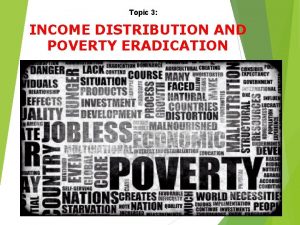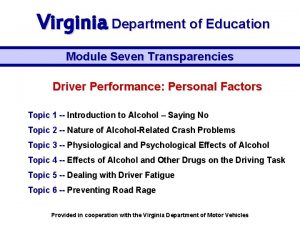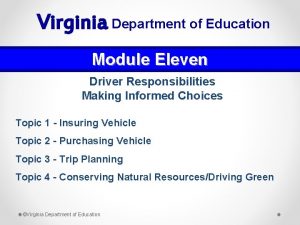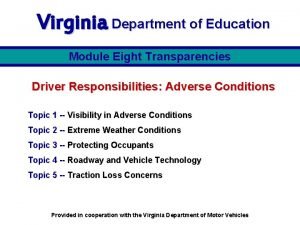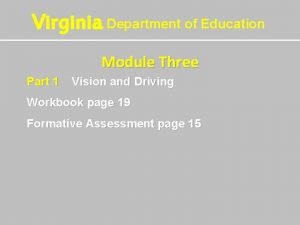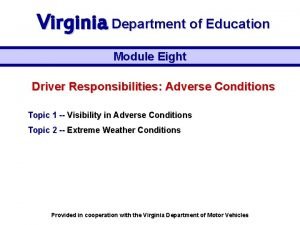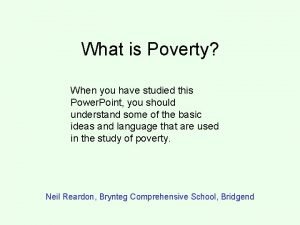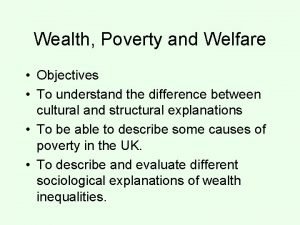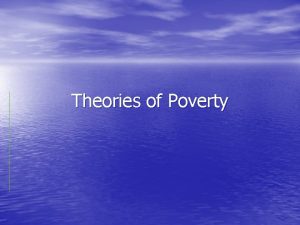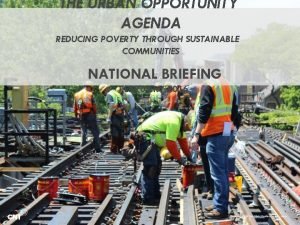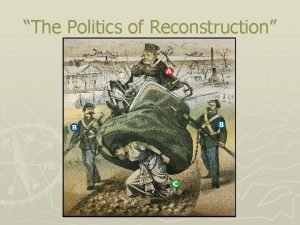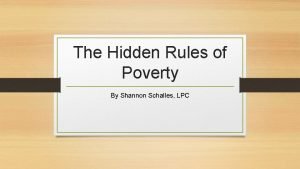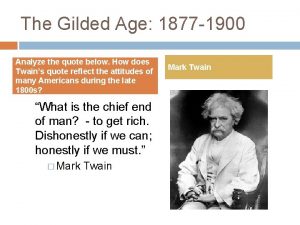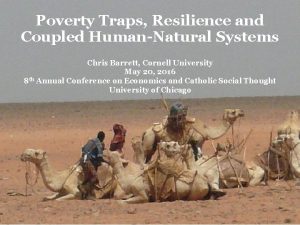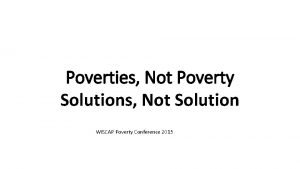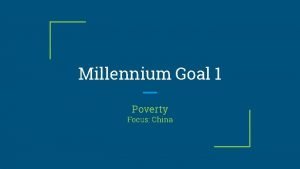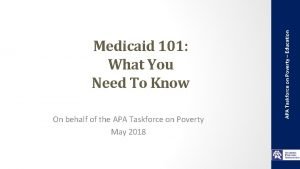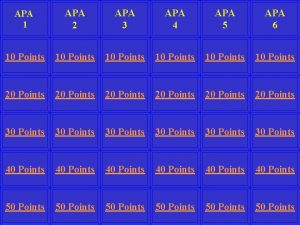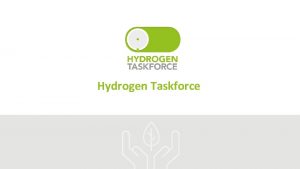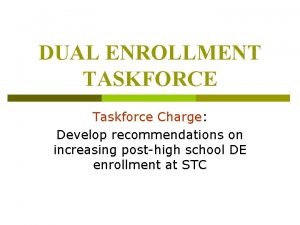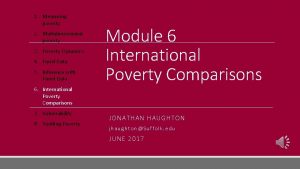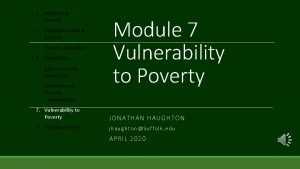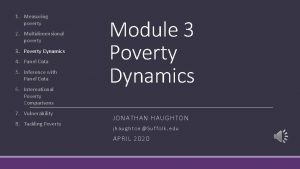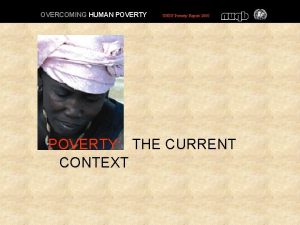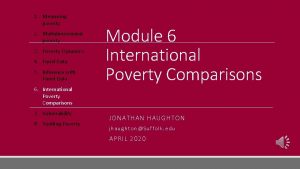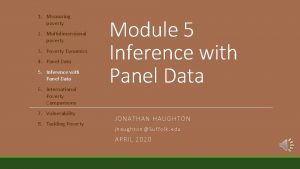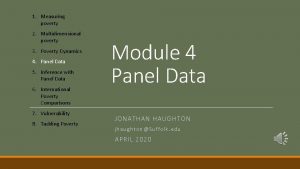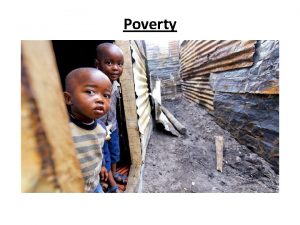APA Poverty Curriculum Module 4 APA Taskforce on























- Slides: 23

APA Poverty Curriculum Module 4 APA Taskforce on Poverty – Education Taking Action to Address Child Poverty

By the end of this module, learners will be prepared to: • Communicate the effect of policy on child health APA Taskforce on Poverty – Education Goal

• Outline the priorities of child advocacy organizations related to child poverty • Discuss the unique voice and power that pediatricians and child health providers possess as advocates for policy • Tailor a message to communicate effectively with different stakeholders about child poverty APA Taskforce on Poverty – Education Specific Objectives

Topic Activities Suggested Time Allocation Poverty Issues Pair share 10 Minutes Poverty Policy Pair Share 10 Minutes Policies and Advocacy Organizations Large group discussion 10 Minutes Physician advocate Large group discussion 10 Minutes Crafting your message Individual work and then large group share 20 Minutes APA Taskforce on Poverty – Education Roadmap

• The AAP policy on Poverty and Child Health (2016) recommends that pediatricians assess the financial vulnerability of their patients’ families in clinic • Thinking over your clinical experiences in the last month, what poverty-related health issues would you have heard if you asked parents, “Do you ever have trouble making ends meet? ” • Turn to the person next to you and discuss: • What are 2 -3 issues you think parents would say? • What could you do for patients in clinic with each issue? APA Taskforce on Poverty – Education Poverty Issues & Pair Share

• Many poverty-related health issues can’t be fixed in clinic. They call for upstream policy solutions • In your pairs consider: How could you take action on one of the most common povertyrelated health issue, food insecurity? • …through a policy change in your clinic or hospital? • …through a policy change in your state? • …through a policy change nationwide? APA Taskforce on Poverty – Education Poverty Policy & Pair Share

• The AAP Federal Advocacy website is a place to find and learn about policies related to child poverty APA Taskforce on Poverty – Education Choose a Poverty-Related Policy

• Consider the priorities and roles of these organizations when looking for allies in action on child poverty policies • Get to know their priorities and partner with them APA Taskforce on Poverty – Education Child Advocacy Organizations

What unique features do physicians bring to advocacy? APA Taskforce on Poverty – Education TAKING ACTION : THE UNIQUE VOICE OF THE PHYSICIAN ADVOCATE

https: //www. youtube. com/watch? v=WHi. Xx 8 QMSrk APA Taskforce on Poverty – Education Example: Taking Action on a Poverty-Related Issue

• In the video you just watched, • Overall, what was effective about the pediatrician’s messaging? • What knowledge made her voice as a pediatrician particularly effective? APA Taskforce on Poverty – Education The Pediatrician’s Voice

• What is uniquely powerful about the voice of pediatricians and clinicians regarding poverty? • We have professional credibility • We focus on data and evidence • We have consistent contact with young children disenfranchised by society • We are witness to the struggles of our families APA Taskforce on Poverty – Education Your Voice as a Pediatrician

APA Taskforce on Poverty – Education TAKING ACTION CRAFTING YOUR MESSAGE

• Let’s think back to food insecurity. It can be addressed at many levels (the clinic or hospital, your health system, community, state, or national) • Think back over your patient experiences who have been uninsured or food insecure. • Look through the websites of prominent children’s advocacy organizations, always start with AAP APA Taskforce on Poverty – Education Analyzing Food Insecurity for Advocacy

• Opening – Two Sentences • State your title as a health professional • Get right to food insecurity (FI) and your policy solution • Body of the Statement – three to four sentences • Explain food insecurity • Connect FI to child health • Tell a recent patient story • Conclusion – Two Sentences • Deliver your “ask” • Look at the AAP’s Federal Advocacy webpage, and find the Child Nutrition section, there you will learn about the AAP’s resources to address food insecurity through advocacy APA Taskforce on Poverty – Education Writing your Brief Statement

Anatomy of a 1 -page letter Name/Issue/Position Honorable Governor Smith: My name is Jane Jones and I am a pediatrician practicing at Apple Valley Children’s Hospital. I applaud and appreciate your past efforts to support funding for ‘Food For All’, our state’s food stamp program. I strongly urge you to keep Food For All as a high priority by fully funding it in your upcoming budget revision. ‘Food For All’ helps the working poor feed their families. In 2015, more than 40% of the patients in our clinic reported not having enough money at the end of the month to buy food for their families. When families do not have enough food their children have worse health and struggle more in school. As a pediatrician, I have many examples of this difficult situation. Just last month I recall seeing a toddler for a check up and the mother reported they did not have enough money to pay for both rent and food. She said she was giving her child water instead of milk which we recommend for healthy tooth and bone development. I was able to connect her to ‘Food For All’ and with their support I am hopeful that the toddler is now getting the calories and nutrients she needs to thrive. For the health of our state’s children, I urge you to ensure continued funding for ‘Food For All’. Again, thank you for your continued support. Please do not hesitate to call me for any questions. Sincerely, [Your Name, MD/Medical Student] [Your Hospital or Clinic] Stat s Personal Story Request

Thinking about food insecurity, how would reducing it affect health? How could reducing food insecurity by changing a policy reduce poverty? How are pediatricians uniquely suited to reduce food insecurity? APA Taskforce on Poverty – Education Connecting the Dots

Remember 1. State you are a pediatrician and constituent 2. Personalize your letter to your stakeholders 3. Use the news 4. Keep it local 5. Keep it brief Source: AAP Advocacy Guide, Page 80 IMPORTANT TIP! If you are doing this work at work, as a part of a hospital or practice, you CANNOT speak for them. You CAN either speak for yourself or reach out to the Government Relations department at your institution and work with them to speak in concert with your institution. APA Taskforce on Poverty – Education Crafting Letter

• Sign up for AAP and other child advocacy groups email alerts • Become an AAP Key Contact • Subscribe to a trusted news site, skim it each day • Call a legislator and leave a quick message • Wear your message with a badge or pin • Share your voice for kids through social media • Write letter to the editor • Vote! APA Taskforce on Poverty – Education Everyone has 5 minutes

• Link to AAP for all modules http: //www 2. aap. org/commpeds/CPTI/trainingmodules. cfm • Case study on Wisconsin “Early Brain Resolution”; https: //docs. legis. wisconsin. gov/2013/proposals /sjr 59 • After finishing your letter, send it to others in your intended audience or adapt it for the Op-Ed page of your local paper. APA Taskforce on Poverty – Education Dig deeper

Facilitators may email learners approximately one week ahead of this module and ask them to: • Read the AAP “Poverty and Child Health in the United States” Policy Statement: http: //pediatrics. aappublications. org/content/earl y/2016/03/07/peds. 2016 -0339 • Consider child poverty-related health issues and their policy foundations to engage through advocacy APA Taskforce on Poverty – Education Pre-work

• Identification of poverty-related issues for advocacy • AAP Federal Legislative Advocacy: https: //www. aap. org/enus/advocacy-and-policy/federal-advocacy/Pages/Federal. Advocacy. aspx • AAP State Legislative Advocacy: https: //www. aap. org/en- us/advocacy-and-policy/state-advocacy/Pages/State-Advocacy. aspx • AAP Community Advocacy: https: //www. aap. org/en- us/advocacy-and-policy/community-advocacy/Pages/Community. Advocacy. aspx • Children’s Defense Fund: http: //www. childrensdefense. org/policy/ APA Taskforce on Poverty – Education Resources

• The APA Task Force on Child Poverty Education Committee Co-Chairs - Lisa Chamberlain, MD, MPH, FAAP & Melissa Klein, MD, MEd, FAAP • Workgroup Leaders - Brian Lurie MD MPH and Adam Schickedanz MD • Content Contributors - Susan Bostwick MD, MBA, Lee Ford-Jones MD, Ambica Nakhasi, MD, Amanda Osta MD, and Barry Solomon MD MPH • Facilitator Guide developer – Melissa Ruiz, MD APA Taskforce on Poverty – Education Acknowledgements
 Taskforce uk hip hop
Taskforce uk hip hop Distinguish between absolute and relative poverty
Distinguish between absolute and relative poverty C device module module 1
C device module module 1 Module 10 topic 1 drivers ed
Module 10 topic 1 drivers ed Module 7 topic 3 drivers ed
Module 7 topic 3 drivers ed Module 11 drivers ed virginia
Module 11 drivers ed virginia Module 8 topic 1 drivers ed
Module 8 topic 1 drivers ed Standard 4 part 1 a: vehicle balance & control
Standard 4 part 1 a: vehicle balance & control Curriculum guide for driver education in virginia module 3
Curriculum guide for driver education in virginia module 3 S.e.e.i.t method driving
S.e.e.i.t method driving Module 7 topic 1 distracted driving
Module 7 topic 1 distracted driving Types of poverty
Types of poverty Structural poverty
Structural poverty Oscar lewis theory
Oscar lewis theory Ways to reduce poverty
Ways to reduce poverty Sharecropper cycle of poverty
Sharecropper cycle of poverty Hidden rules of poverty
Hidden rules of poverty Gilded age quote
Gilded age quote Poverty of the stimulus
Poverty of the stimulus Social class sailmaker
Social class sailmaker Types of poverty in economics
Types of poverty in economics Defining poverty
Defining poverty Poverties
Poverties Causes of poverty
Causes of poverty

